Getting quotes for a new B2B website can feel like stepping into a maze blindfolded. One agency quotes you $5,000. Another says $50,000. A freelancer promises they can do it for $2,500. Meanwhile, your colleague swears their nephew can build something "just as good" for a few hundred bucks.
The confusion is real, and it's frustrating. How can the same project have such wildly different price tags? What are you actually paying for? And how do you know if you're getting ripped off or if that suspiciously low quote means corners will be cut?
This guide cuts through the confusion. We'll show you what really drives website costs for B2B companies. You'll learn what to expect at different price points, what hidden costs to watch for, and how to make smart decisions about your investment.
B2B website design is very different from B2C. It hasunique challenges that affect cost. Your website needs to educate multiple decision-makers, integrate with complex systems, and generate qualified leads. Understanding these differences is the first step to making sense of website pricing.
What Makes B2B Websites Different (And More Complex)
B2B websites work harder than their consumer counterparts. Your potential customers aren't making impulse purchases. They're researching solutions for months, comparing options, and getting buy-in from multiple stakeholders.
This longer sales cycle means your website needs sophisticated content that speaks to different audiences. The IT director wants technical specifications. The CFO needs ROI calculations. The end users care about ease of implementation.
Your website has to serve all these needs seamlessly.
Technical Requirements
Beyond needing strategic content for different audiences, you also have to consider your technical requirements. These include platform integrations, security and compliance, scalability, and lead generation infrastructure.
Platform Integrations
B2B websites often need to connect with CRM systems, marketing automation platforms, and other business tools. These integrations aren’t just nice to have.
They’re essential for:
- Tracking leads
- Nurturing prospects
- Measuring ROI
Security and Compliance
Security and compliance add another layer of complexity. If you're in healthcare, finance, or government contracting, your website might need to meet strict regulatory standards. These requirements affect everything from hosting choices to form handling.
Scalability
Your website also needs to scale with your business. Consumer sites might get away with basic functionality, but B2B sites need room to grow.
Over time, you may want to:
- Add new service pages
- Publish case studies
- Expand into new markets
- Integrate new tools
Building this flexibility from the start costs more upfront but saves money long-term.
Lead Generation Infrastructure
Lead generation requirements set B2B sites apart too. You're not just displaying information.
You're also:
- Capturing qualified leads
- Scoring them
- Routing them to sales teams
- Nurturing them through automated campaigns
This functionality requires careful planning and robust technical infrastructure.
The Real Cost Ranges: What to Expect in 2025
DIY Website Builders ($50-$500/Year)
The DIY route using platforms like Wix, Squarespace, or basic WordPress themes works for some situations. If you're a startup testing a new idea or a solopreneur just getting started, these tools can get you online quickly.
For this minimal investment, you'll get a basic web presence. You can choose from templates, add your content, and publish a simple site. Most platforms include hosting, basic security, and some marketing tools.
But there are significant limitations, like:
- Customization is limited to what the platform allows
- SEO capabilities are basic
- Integration options are minimal
And as your business grows, you'll likely hit walls that force you to start over on a more robust platform.
Hidden costs pop up quickly too, which include:
- Premium themes
- Additional plugins
- Custom email addresses
- Removing platform branding
These all add to your annual costs. What starts as $50 can easily become $500 or more.
Freelancer-Built Sites ($2,500-$15,000)
Working with a freelancer represents a significant step up from DIY. A skilled freelancer can create a custom design, write conversion-focused copy, and implement more advanced functionality.
Projects at this level typically include:
- Custom design work
- Basic SEO optimization
- Mobile responsiveness
- Some level of content management system customization
- 10-20 pages
- Contact forms
- Basic analytics setup
The freelancer route works well for established small businesses with straightforward needs. You know your market, have clear messaging, and need a professional online presence without extensive functionality.
However, freelancers often work alone, which can affect timelines if they get sick or overbooked. They might excel at design but struggle with complex development, or vice versa. Ongoing support can also be challenging if your freelancer moves on to other projects.
Small Agency Projects ($15,000-$50,000)
Small agencies bring teams to your project. Instead of relying on one person's skills, you get specialists in strategy, design, development, and project management. This collaborative approach typically produces more polished, strategic results.
At this investment level, expect a thorough discovery process. A small agency should:
- Research your market
- Analyze competitors
- Develop a comprehensive strategy
- Create custom designs based on user research – not just aesthetic preferences
Your site will also include advanced functionality like:
- Marketing automation integration
- Lead scoring
- Detailed analytics tracking
Content strategy becomes a major focus, with professional copywriting that speaks to your different audience segments.
Agencies at this level also provide better project management, including:
- Regular check-ins
- Clear timelines
- Structured feedback processes
Post-launch support is typically more reliable too.
A Small Agency Success Story in Action: Trajectory and MGA
When MGA Research Corporation approached Trajectory, they had a complex story to tell across multiple industries, from automotive testing to aerospace safety. We kicked things off with a deep discovery process to understand their audiences, business goals, and unique service offerings. From there, we built a clean, modern design that highlights MGA’s expertise and makes it easy for visitors to explore industry-specific content.
The redesigned site features strategic content, more intuitive structure, dual pathways for different stakeholders, and elevated digital authority to match the company’s industry reputation. By investing in work with a small B2B website redesign agency like Trajectory, MGA’s team obtained a platform that reflects their reputation for innovation, while also being flexible enough to evolve with the company over time.
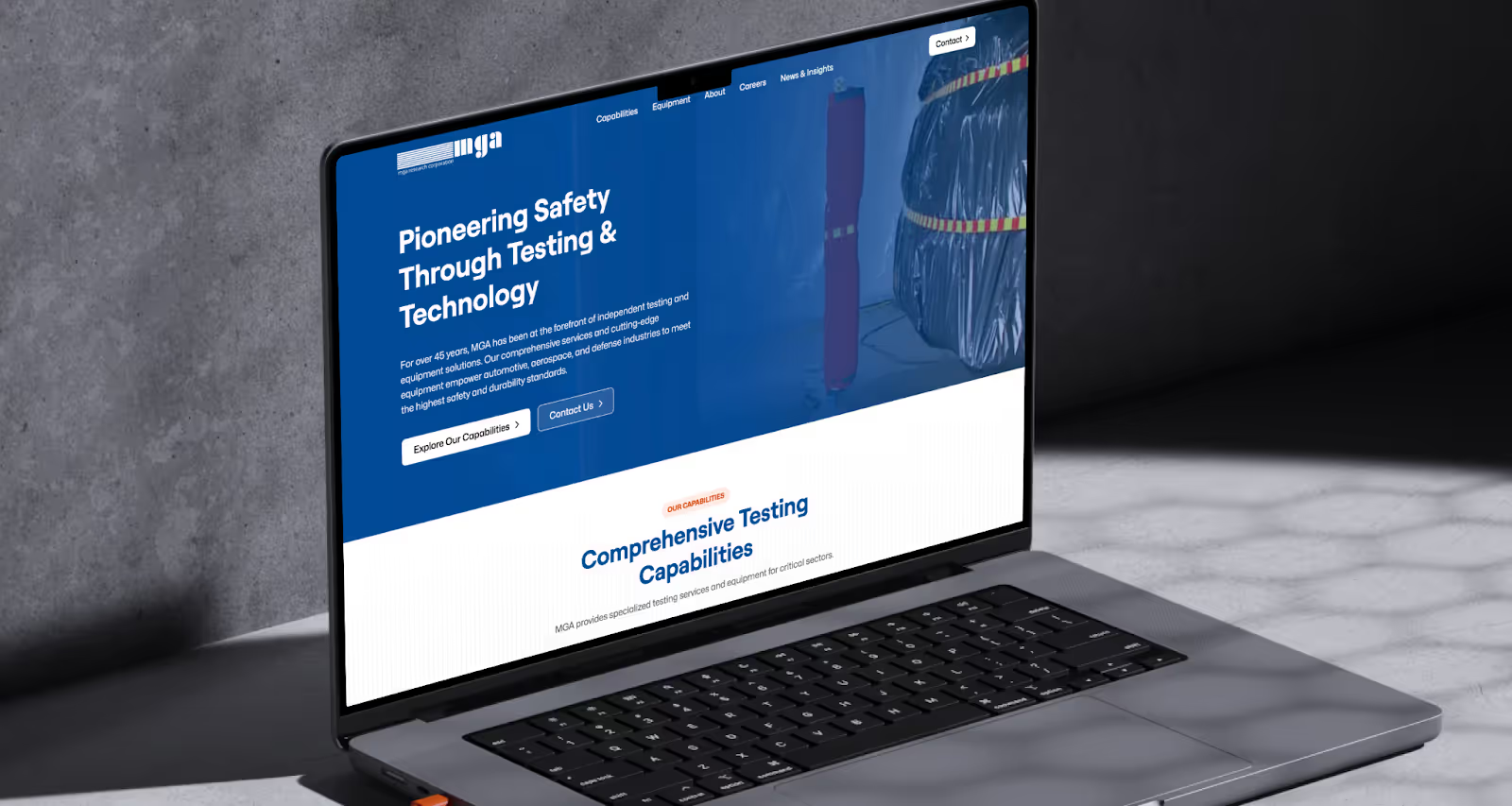
Full-Service Agency Sites ($50,000-$150,000+)
Enterprise-level projects involve comprehensive digital strategy beyond just building a website. These agencies position your website as the centerpiece of a broader digital marketing ecosystem.
Expect extensive user research, including interviews with your customers and stakeholders. The agency will develop detailed personas, map customer journeys, and create content strategies for each stage of the buying process.
Technical capabilities expand significantly to include:
- Custom applications
- Advanced personalization
- Multi-language support
- Sophisticated integrations
- Customer portals
- Resource libraries
- Interactive tools
The timeline stretches too. Enterprise projects often take 6-12 months, involving multiple departments and extensive testing.
But you're not just getting a website. You're getting a digital platform that can drive business growth for years.
Enterprise Design in Action: IBM
IBM’s homepage is a great example of enterprise-level web design. Right away, you’ll notice the clean, modern layout that feels both professional and approachable. The site offers extensive navigation options, making it easy for users to explore solutions by product type, role, or technology.
This kind of structured, deep navigation is typical for enterprise sites that serve multiple audiences. It’s clear that the design prioritizes usability at scale, guiding different users to the content that matters most to them.
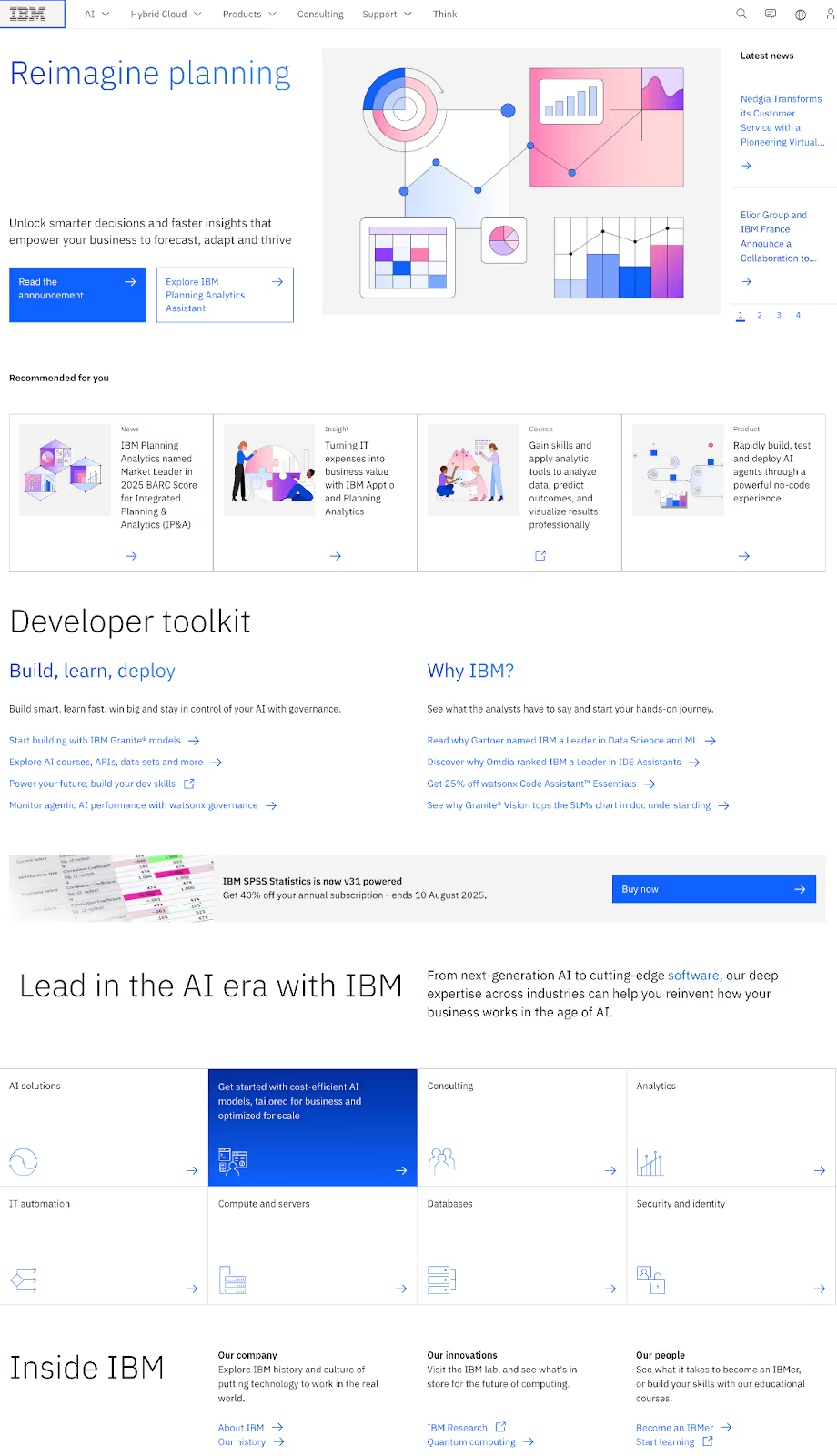
In-House Development (Variable Costs)
Some B2B companies choose to build internal web development teams.
This makes sense if you:
- Need constant updates
- Have unique technical requirements
- View your website as a core competitive advantage
The costs vary wildly based on location and experience level. A single full-stack developer might cost $80,000-$150,000 annually, plus benefits. Add designers, content creators, and project managers, and you're looking at significant ongoing investment.
Building an internal team offers maximum control and flexibility. Your team learns your business deeply and can respond quickly to new needs. But you also take on management overhead, training costs, and the risk of key people leaving.
Many companies find a hybrid approach works best. They maintain a small internal team for day-to-day updates while partnering with agencies for major projects or specialized skills.
Payment Models and Terms: What to Expect
Understanding payment structures helps you compare proposals fairly and avoid cash flow surprises. Most web projects use one of several standard payment models:
- Fixed-Price Offers Predictability: Fixed-price projects mean you know exactly what you'll pay, making budgeting straightforward. This model works best when the project scope is clear and unlikely to change. However, scope changes typically trigger additional costs.
- Hourly Billing Adds Flexibility for Evolving Projects: With hourly billing, you pay for actual time spent, which can be economical for smaller projects. But costs can spiral if the project expands or hits unexpected challenges. Clear communication about time estimates becomes crucial.
- Milestone Payments Spread Costs Across Project Phases: For example, you might pay 25% at signing, 25% after design approval, 25% after development, and 25% at launch. This structure aligns payments with progress and gives both parties security.
- Retainer Models Cover Ongoing Work: With a retainer model, you pay monthly for maintenance, updates, and improvements after the initial build. This ensures dedicated resources and faster response times for changes.
Red Flags Signal Risk
Watch for red flags in payment terms. Demands for large upfront payments (over 50%) signal potential risk. Vague terms about what triggers payments create conflict later. And be wary of contracts that don't clearly define deliverables for each payment milestone.
Breaking Down the Cost Components
Strategy and Planning (15-25% of Budget)
Strategic planning might seem like expensive talking, but it's the foundation of successful B2B websites. This phase includes discovery, content strategy, and UX planning to uncover what your customers actually need – not just what you think they want.
Discovery
Discovery sessions reveal how your sales process really works. Research shows what messages resonate with your audience. Competitive analysis identifies opportunities to differentiate. This isn't theoretical work – it directly shapes every decision that follows.
For example, one survey by the Nielsen Norman Group revealed that 84% of 240 UX professionals believe taking time for a discovery phase had a positive impact on the products or services they helped build. That’s a strong vote in favor of slowing down before jumping into design or development. Even a lightweight discovery process can clarify goals, reduce wasted effort, and align teams early, setting the stage for better outcomes down the line.
Content Strategy
Content strategy development during the planning phase answers questions like:
- Which topics will attract your ideal customers?
- What questions do they need answered at each buying stage?
- How will you organize information for different user types?
These decisions affect your site's success more than any design element.
UX Planning
User experience (UX) planning maps how visitors will move through your site, preventing expensive fixes after launch. This phase will help you answer questions including:
- Where do they enter?
- What actions do you want them to take?
- What might make them leave?
Design and User Experience (20-30% of Budget)
Design isn't just making things pretty. For B2B websites, design must balance professional credibility with clear communication and conversion optimization.
You’ll need to consider:
- Brand Alignment: This ensures your website reinforces your market position. A cutting-edge tech startup needs a different design language than an established consulting firm. During this phase, your designer translates brand values into visual elements that resonate with your specific audience.
- Responsive Design Complexities: Responsive design goes beyond making things fit on phones. B2B users might research on mobile, compare options on tablets, and make final decisions on desktops. Each experience needs optimization for its context.
- Prototype Development: Prototypes let you test ideas before expensive development begins. Interactive prototypes reveal usability issues early (when fixes are cheap). They also help stakeholders visualize the final product, reducing late-stage revision requests.
- Design Rounds: These aren't indulgence – they're necessary refinement. First concepts establish direction, while revisions incorporate feedback and refine details. Final rounds polish the experience. Rushing this process often means living with compromises for years.
Content Development (15-25% of Budget)
Words sell B2B products and services. Your website copy needs to educate, persuade, and convert sophisticated buyers who've done their homework.
Content development includes:
- Professional Copywriting: This goes beyond describing what you do. It articulates value propositions, addresses objections, and guides visitors toward conversion. Good copy speaks to emotions while respecting your audience's intelligence.
- SEO: Search engine optimization weaves naturally into good copy. It's not about keyword stuffing but understanding how your customers search and matching their language. This organic approach improves rankings while maintaining readability.
- Visual Content: This often requires significant investment. Stock photos rarely capture your specific value proposition. Custom photography, infographics, and illustrations help you stand out while explaining complex concepts clearly.
- Content Migration: Migrating your content seems simple but often becomes complex. Old content needs review, updating, and reorganization. Broken links need fixing. Meta descriptions need writing. This tedious work significantly affects your launch timeline if underestimated.
How Mailchimp Showcases Benefits-Driven Copy
Mailchimp’s homepage is a great example of benefit-focused copy done right. Instead of just listing features, the messaging clearly highlights what users get out of the platform – like getting more email opens and clicks, turning emails and texts into revenue, and building long-lasting customer relationships.
Phrases like “Convert with email & SMS,” “Create relevant content faster,” and “Optimize with analytics & reporting” speak directly to outcomes, not tools. This copy is written in a way that feels approachable but polished, making it clear that professional copywriters crafted each line with the end user’s goals in mind.
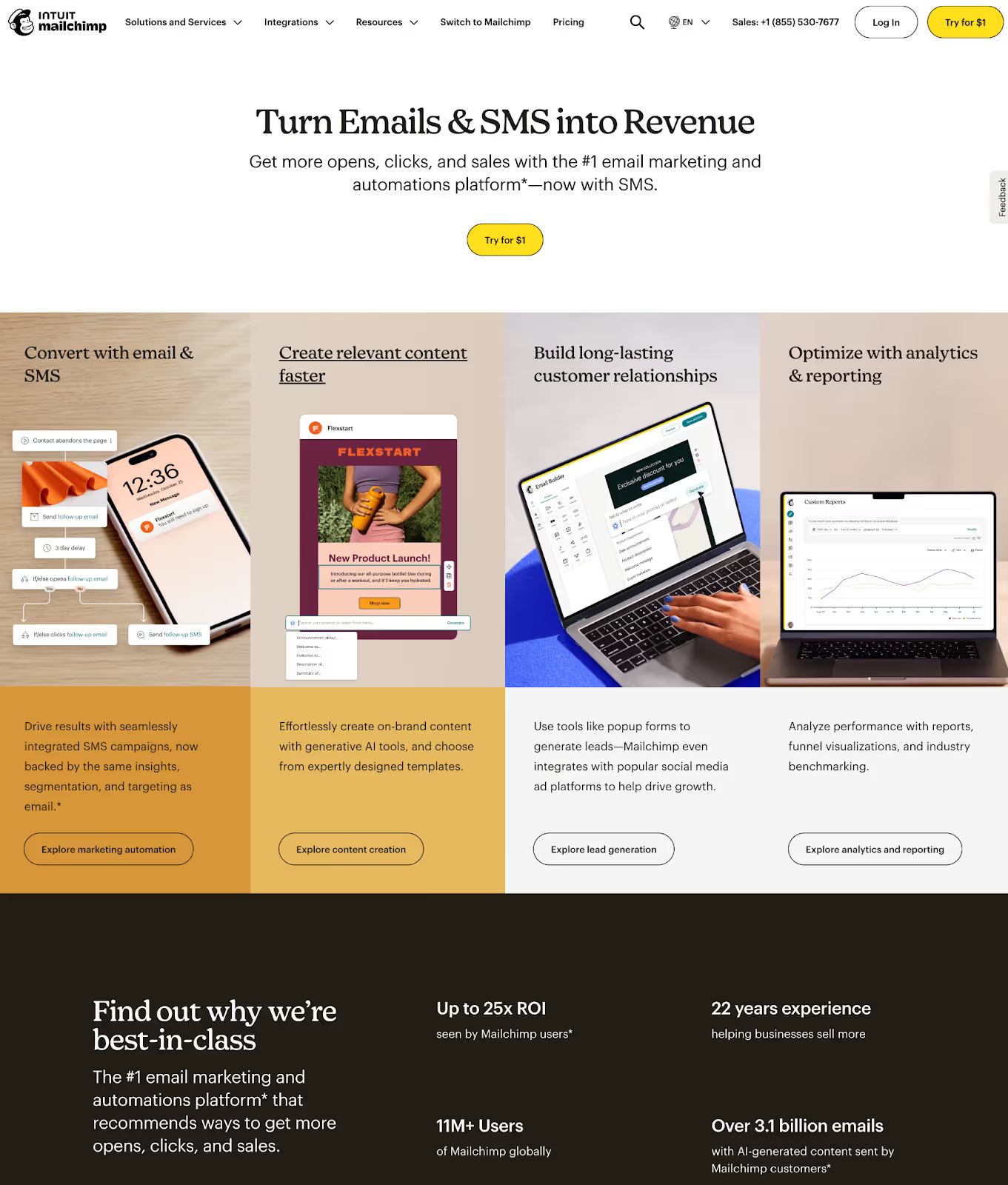
Development and Technical Implementation (25-35% of Budget)
Development transforms designs into functional websites. This phase often holds the most surprises for B2B companies, especially around integration requirements.
Development and technical implementation includes:
- Platform Selection: The hosting platform you choose affects everything. WordPress offers flexibility and a huge ecosystem but requires ongoing maintenance. Webflow provides visual development tools and reliable hosting but has a learning curve. HubSpot CMS integrates deeply with their marketing tools but locks you into their ecosystem.
- Custom Functionality: This separates B2B sites from basic brochure sites. Quote calculators, dealer locators, resource libraries, and customer portals all require significant development time. Each feature needs planning, building, testing, and optimization.
- Third-Party Integrations: Integrations often consume unexpected time. Your CRM might have an API, but making it work smoothly with your website requires custom development. Marketing automation connections need testing across various scenarios. Payment processing adds security requirements.
- Performance Optimization: This can't be an afterthought. B2B buyers won't wait for slow pages. Developers must optimize images, minify code, implement caching, and use content delivery networks. These technical details directly impact your conversion rates.
Project Management (10-15% of Budget)
Project management feels like overhead until you've experienced a project without it. Good project management keeps complex projects on track, on budget, and on time.
Here are a few ways strong project management makes a tangible difference:
- Communication Coordination: This becomes crucial when multiple stakeholders are involved. Project managers facilitate feedback, resolve conflicts, and keep everyone aligned. They translate between technical teams and business stakeholders.
- Timeline Management: Managing timelines prevents costly delays. Dependencies get mapped, resources get allocated, and bottlenecks get addressed before they cause problems. When issues arise – and they always do – project managers adjust plans to minimize impact.
- Quality Assurance: QA checks should happen throughout, not just at the end. Project managers ensure each phase meets standards before moving forward. This prevents compounding problems and expensive late-stage fixes.
Hidden Costs Most B2B Companies Forget
The initial build is just the beginning. B2B websites require ongoing investment to remain effective and secure.
As you begin to research B2B website costs, don’t forget about:
- Annual Hosting Costs: Hosting expenses vary widely based on your needs. Basic shared hosting might cost $200 yearly, but B2B sites often need dedicated servers or cloud hosting that runs $500-2000 monthly. Factor in content delivery networks, backup services, and security monitoring.
- Software Licenses: Licenses add up quickly. Premium plugins, form builders, analytics tools, and security software often charge annual fees. That "free" CMS might require $500-1000 yearly in essential paid extensions.
- Content Updates: Content refreshes seem minor but accumulate over time. Adding case studies, updating team pages, posting blogs, and refreshing service descriptions takes time. Whether you handle this internally or hire help, be sure to budget for continuous content development.
- Technical Maintenance: You’ll need consistent maintenance to prevent disasters. Software updates, security patches, and compatibility fixes need regular attention. Neglecting maintenance leads to security breaches, broken features, and eventually complete rebuilds.
- Marketing Technology Costs: Technology expenses often surprise B2B companies. A/B testing tools, heat mapping software, conversion optimization platforms, and advanced analytics all improve performance but add to your monthly bills.
- Training: Team training matters more than most companies expect. Your team needs to learn the CMS, understand SEO basics, and follow brand guidelines. Budget for initial training plus refreshers when staff changes.
Understanding the Real Cost of Platforms Like HubSpot
Let’s take a look at how marketing automation and related tools represent significant ongoing costs. If you explore HubSpot’s price page, you’ll see that the platform’s options for individuals and small teams are reasonably priced. However, costs can jump considerably per month depending on how many seats you need.
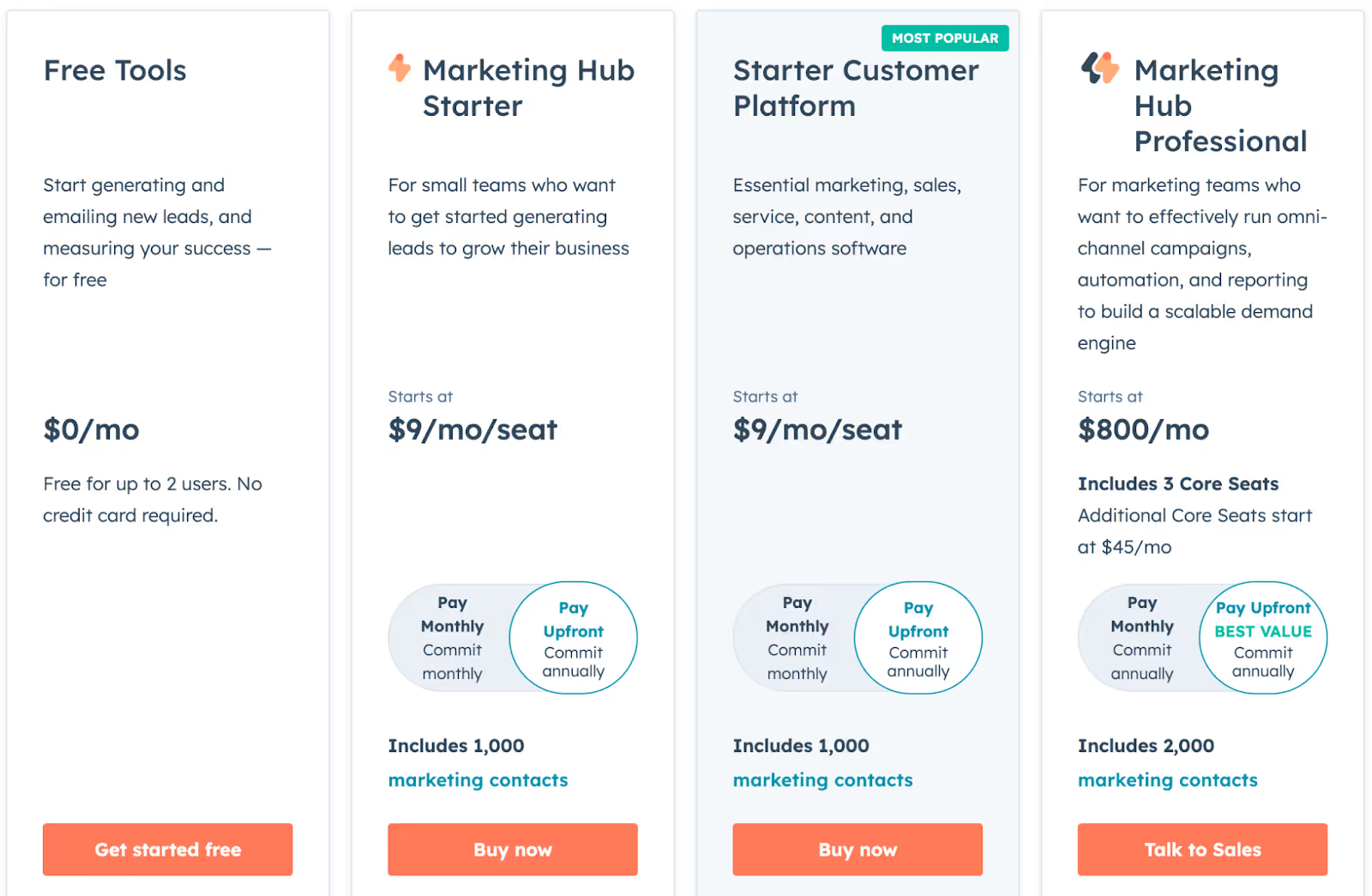
If you’re operating at the business or enterprise level, you can expect to pay significantly more for Marketing Hub Professional or Marketing Hub Enterprise, investing either $9,600 or $43,200 into the platform each year.
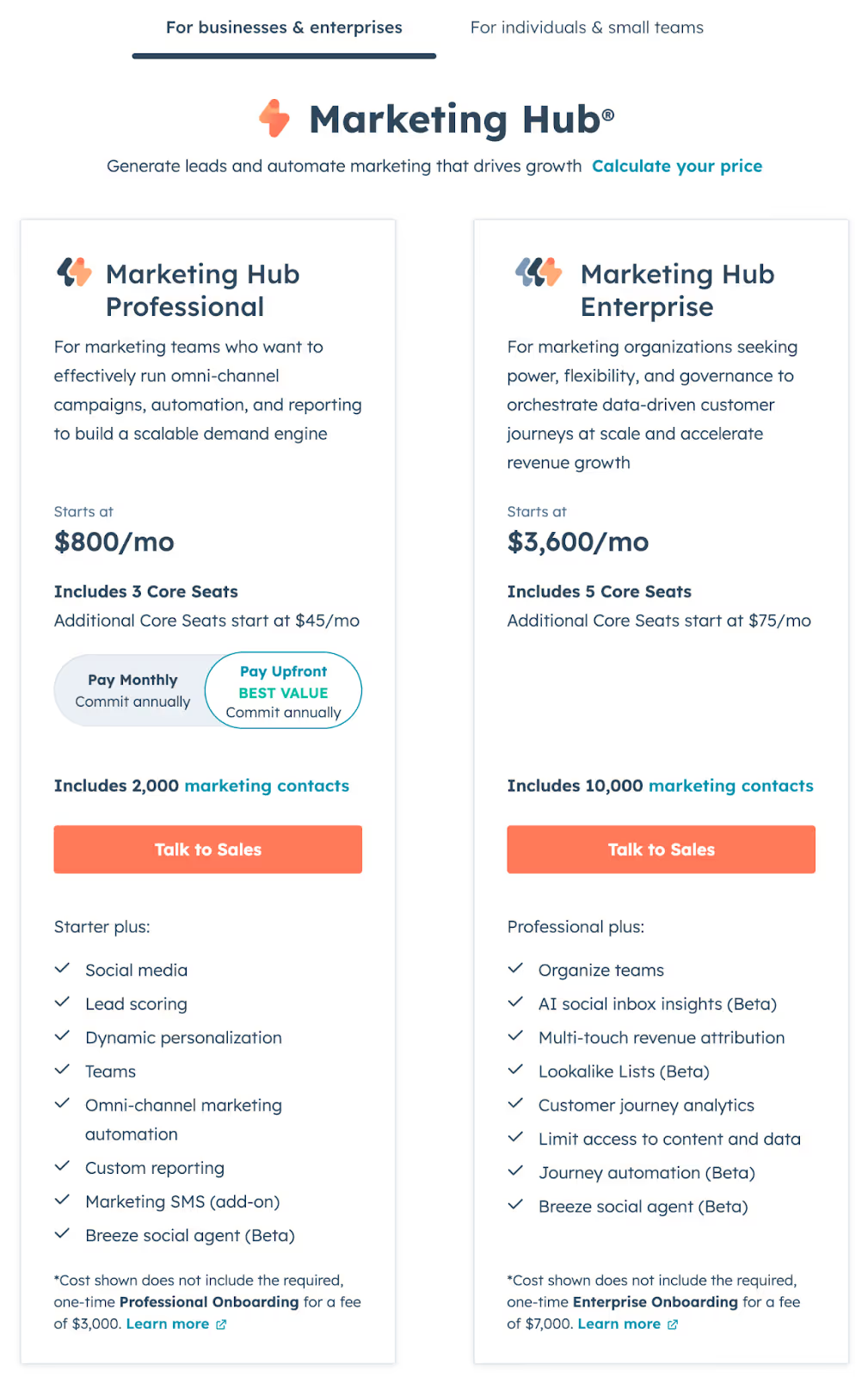
You also shouldn’t overlook the cost of the required, one-time onboarding fee, which runs between $3,000 and $7,000. When you factor in the software subscription, onboarding fees, extra seats, and additional add-ons, it’s easy to see how the total investment adds up fast.

Factors That Drive Your Costs Up (Or Down)
Understanding cost drivers helps you make strategic decisions about where to invest and where to save.
Cost Increasers:
- Custom Functionality: Custom features always cost more than standard features. If your business model requires unique tools, calculators, or workflows, expect significant development time. But custom features can also provide competitive advantage.
- Multiple Stakeholder Involvement: Multiple stakeholders add complexity. When five departments need input, decisions take longer. More opinions mean more revisions. Clear governance structures help but don't eliminate the added time.
- Extensive Content Migration: The migration process often surprises clients. Moving hundreds of pages, updating formats, and fixing broken elements takes serious time. Automated tools help but human review remains essential.
- Marketing Automation: Automation complexity multiplies with sophistication. Basic email capture is simple – but lead scoring, progressive profiling, and behavior-triggered campaigns require careful planning and testing.
- Rush Timelines: Shorter project timelines increase costs dramatically. Agencies charge premiums for fast turnarounds because they must dedicate more resources and often work overtime. Planning ahead saves money.
Cost Reducers:
- Clear Project Scope: A clear scope prevents expensive wandering. When you know exactly what you need, agencies can quote accurately and work efficiently. Vague requirements lead to scope creep and budget overruns.
- Organized Existing Content: Organizing your content saves significant time. If you provide clean, updated copy in organized files, you'll avoid paying agency rates for content gathering and organization.
- Decisive Project Leadership: Confident leadership accelerates timelines. When one person can make decisions quickly, projects move smoothly. Committee-based decisions slow progress and increase costs.
- Flexible Timelines: Adaptable timelines let agencies optimize resource allocation. If you can work around their busy periods, you might negotiate better rates. Rigid deadlines limit options.
- Standard Functionality: Standard features cost less than custom solutions. Sometimes off-the-shelf plugins or standard features meet your needs perfectly. Don't pay for custom development unless it provides real business value.
Choosing the Right Platform for Your Budget
Platform choice significantly affects both initial and ongoing costs. Each option has tradeoffs between flexibility, ease of use, and total cost of ownership.
Webflow
Webflow has emerged as a sweet spot for many B2B companies. It offers visual development tools that speed up builds while maintaining code quality. Hosting is included and reliable. The CMS is intuitive enough for marketing teams to manage content without developer help.
At Trajectory, we've found that Webflow provides the best balance of capability and cost for most B2B projects. When we partnered with EVPassport, we selected Webflow as our platform of choice to create a website as cutting-edge as the company’s technology. Webflow’s flexibility and powerful design tools allowed us to create a sleek, professional website on a tight timeline – without compromising quality.
The result was a responsive, visually polished site that seamlessly guides visitors through EVPassport’s offerings, with industry-specific pages tailored to their diverse clientele.

WordPress
WordPress powers much of the web but requires careful management. The platform itself is free, but premium themes, essential plugins, and security measures add costs. WordPress sites need regular updates and maintenance to stay secure. For complex B2B sites, WordPress can work well but requires ongoing technical attention.
HubSpot
HubSpot CMS integrates deeply with their marketing platform. If you're already using HubSpot for marketing automation, their CMS offers seamless connections. However, you're locked into their ecosystem, and costs escalate as you grow. The platform works best for companies fully committed to HubSpot's methodology.
Custom Development
Custom development makes sense for unique business models or when your website is your product. Complete control comes with complete responsibility for maintenance, security, and updates. Budget for ongoing development resources, not just the initial build.
Remember: platform migration costs catch many companies off-guard. Moving from one platform to another often costs 50-70% of a new build. Consider long-term needs when choosing initially to avoid expensive migrations later.
How to Budget Smartly for Your B2B Website
Smart budgeting starts with business goals, not feature lists. What business problems will your website solve? How will it generate revenue or reduce costs? Clear answers guide appropriate investment levels.
- Consider Total Cost Over Time: Total cost of ownership matters more than initial price. A cheaper build that requires constant fixes costs more than a solid foundation that lasts years. Calculate costs over 3-5 years including hosting, maintenance, updates, and eventual redesign.
- Budget for the Unexpected: Building in a 15-20% buffer prevents stress when unexpected needs arise. Projects rarely go exactly as planned. Having contingency funds means you can address issues properly rather than accepting compromises.
- Use a Phased Approach: Phased approaches work well for limited budgets. Launch with core functionality, then add features based on user feedback and business growth. This approach often produces better results than trying to build everything upfront.
- Start with Simplicity: Starting simple makes sense when you're uncertain about requirements. A solid foundation that converts visitors beats a complex site that confuses them. You can always add sophistication as you learn what users actually want.
- Plan for Future Growth: Planning for scalability from the start saves money long-term. Choose platforms and architectures that can grow with your business. Build flexible templates that accommodate new content types. Consider future integration needs even if you're not ready to implement them.
Benefits of Iterative Development
We recommend a phased development approach to reduce risk and improve outcomes. Here are a few key benefits of iterative development to consider:
- Faster Launches With Less Risk: Delivering small, working features early speeds up time-to-market and helps uncover problems before they become costly.
- Better Quality Through Iteration: Continuous testing and refinement in each cycle catch bugs early, reduce rework, and lead to a more stable product.
- Flexibility to Adapt as You Go: Iterative development makes it easy to respond to changing goals, market shifts, or new technology without derailing progress.
- Ongoing Improvement and Feedback: Frequent check-ins, retrospectives, and user reviews keep the team learning and improving while ensuring the product stays aligned with real needs.
- Stronger Stakeholder Involvement: Regular updates and collaboration keep everyone engaged, leading to higher satisfaction and a product that meets both business and user goals.
Red Flags: When Pricing Seems Too Good to Be True
Watch out for these common red flags when evaluating web design proposals. Each one can signal deeper issues that may cost you time, money, or both down the line.
- Unrealistic Timelines: Rushed or unrealistic timelines signal potential problems. Professional B2B websites require time for proper strategy, designing, building, and testing. Anyone promising a complex site in two weeks either doesn't understand the scope or plans to cut corners.
- No Discovery: Lack of a discovery phase means the agency doesn't care about your business goals. They're selling you a template solution regardless of your needs. Without understanding your market and objectives, how can they create something effective?
- Vague Deliverables: Unclear deliverables lead to disappointment and conflict. Proposals should specify exactly what you'll receive: number of pages, revision rounds, functionality details, and post-launch support terms. Vague promises mean different things to different people.
- Too Few Revisions: Limited revisions seem reasonable until you need them. Professional projects include adequate revision rounds. Agencies confident in their process don't nickel-and-dime over feedback incorporation.
And remember: offshore work requires extensive vetting that goes beyond price. Time zone differences complicate communication. Cultural differences affect design decisions. Legal recourse becomes difficult if problems arise. Some offshore teams deliver quality work, but due diligence becomes crucial.
Making Your Investment Count: ROI Considerations
B2B website investments should generate measurable returns. Understanding potential ROI helps justify budgets and set realistic expectations.
- Lead Value Calculations: These calculations put website costs in perspective. If your average deal size is $50,000 and your close rate is 20%, each qualified lead is worth $10,000. A website that generates just one extra lead monthly pays for itself quickly.
- Customer Lifetime Value: The lifetime value of customers often surprises B2B companies. That $10,000 first purchase might represent $100,000 over the relationship. Websites that improve retention and encourage expansion become incredibly valuable assets.
- Efficiency Gains: These gains compound over time. Self-service resources reduce support calls. Clear information shortens sales cycles. Online tools eliminate manual processes. These improvements free your team for higher-value activities.
- Brand Perception Improvements: Boosted brand perception is harder to measure but equally real. Professional websites build trust with enterprise buyers. They help you compete above your weight class. They attract better talent and partners.
- Conversion Rate Improvements: Improved conversion rates multiply all other marketing efforts. If you're spending on ads, content marketing, or trade shows, a better website improves ROI on all these investments. Small conversion improvements create a huge cumulative impact.
Your Next Steps: How to Move Forward
Here are the next steps you can take to prepare for your B2B website redesign:
- Evaluate Your Existing Website: Start by honestly assessing your current website's performance. Does it generate qualified leads? Do visitors find what they need? Does it reflect your current market position? Objective evaluation reveals whether you need refinement or complete overhaul.
- Define Your Goals: Next, define clear business objectives before talking to agencies. What specific outcomes do you need? More leads? Better lead quality? Shorter sales cycles? Higher conversion rates? Specific goals lead to focused solutions.
- Establish a Budget: Then, set a realistic budget range based on your business size and goals. If your average deal size is $100,000, investing $50,000 in a website that improves conversion by just 2% generates tremendous ROI. But if you sell $500 monthly subscriptions, that same investment needs different justification.
- Gather Key Information: Finally, prepare for the selection process by gathering necessary information. Compile existing analytics data, document your sales process, list integration requirements, and clarify decision-making authority. Preparation streamlines agency conversations and improves proposals.
Key questions for potential partners include:
- How do they approach discovery?
- What's their process for understanding your business?
- How do they measure success?
- What happens after launch?
Their answers reveal whether they're true partners or just vendors.
Conclusion: Your Website Deserves Strategic Investment
B2B website costs vary dramatically because B2B needs vary dramatically. A startup testing market fit needs different solutions than an enterprise serving global clients. Understanding these differences helps you invest appropriately.
Remember that value matters more than cost. A $50,000 website that generates millions in revenue provides better ROI than a $5,000 site that sits idle. Focus on business outcomes, not just expense reduction.
You’ll also need to think strategically about your website investment. Consider where your business will be in three years, not just current needs. Build flexibility for growth. Plan for ongoing optimization.
Your website is infrastructure, not decoration. It works 24/7 to educate prospects, generate leads, and support customers. Investing appropriately in this critical business asset pays dividends for years.
The right partner makes all the difference. Whether you choose a freelancer, agency, or internal team, find partners who understand your business and share your goals. The relationship matters as much as the deliverables.

